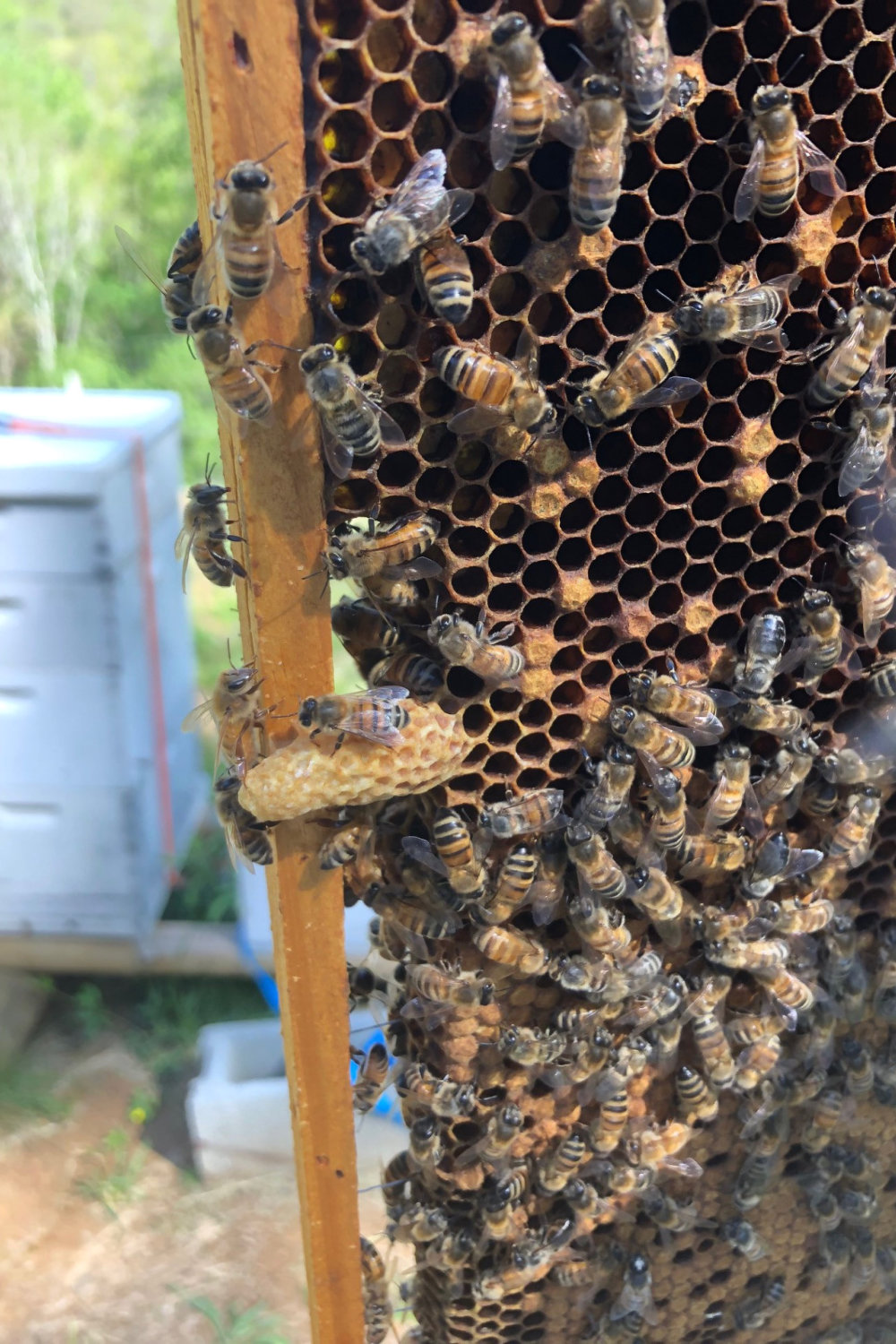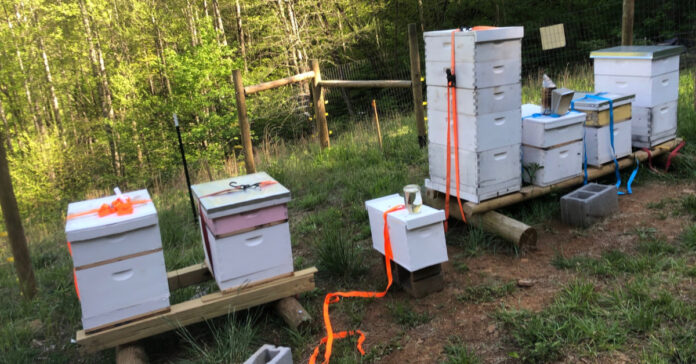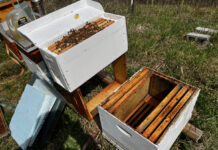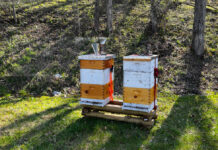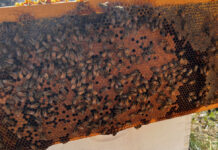I had been planning to inspect my beehives for the past week, but rain and cold temps kept me from doing so. After inspecting all six hives on Monday, I can tell you the weather didn’t seem to slow down the bees very much.
Spring Honey Production
I already had a honey super on one strong hive. Surprisingly, the super was full of nectar after only two weeks. They had not converted this to honey yet (probably too damp and cool), but I was pleased that there was this much nectar available this early in the year. I added a second super to it. With any luck, it may even take a third one in a few weeks. This hive had some dry queen cups at the bottom of the hive. I inspected them carefully, but there was no royal honey or larvae in any of them. Using my hive tool, I smashed the cups. I also moved around a few frames to give the queen more room to lay.
The other hive that successfully overwintered is also doing well. I gave it its first honey super. This hive was showing no signs of swarming pressure, but the bees were cranky. One stung me on the thumb which made lifting frames a pain tin the… thumb for the rest of the day.
Right now, I have three medium honey supers in place. The blackberry bushes have not yet bloomed, but there are buds on them. Locals consider it the start of the spring honey flow when the blackberries bloom. I’m going to start making some more medium frames supers to ensure I’m ready for it!
The Splits
If you recall, I had split two hives and added a queen cup to both the splits. Monday was the 17th day since the queens had emerged, so it was the perfect time to check and confirm they had successfully completed their mating flights and returned to the hives.
In hive five, everything looked good. There were eggs and young larvae. This young brood will begin to hatch in another two weeks. I filled their hive top feeder and closed the hive back up. The hive will miss much of the spring honey flow, but it should be ready for the summer honey flow. With luck and some good planning, it will produce harvestable honey in July.
The queen in the second hive had emerged from her queen cup but had not made it back from her mating flight. I was not surprised, as we’d had some cold and rainy weather a few days after she hatched. I am satisfied with a 50 percent success rate. I’ll tell you what I did with this hive a bit later.
The Nucs
I also added two nucs this year, one 18 days ago and one about two weeks ago.
The most recent nuc looked good. There were 7 frames of bees visible when I opened it and it had 5 frames of brood. I refilled its feeder and made a note to add a second hive body or a super in a few days. This hive might produce honey during the spring flow and definitely will during the summer flow.
The second nuc looked fantastic. It had exploded with growth and was packed with bees. Too packed, in fact. There were at least four or five frames that had swarm cells on them, which is a sign that the hive is getting ready to swarm. This was the first time I had seen capped swarm cells in one of my own hives.
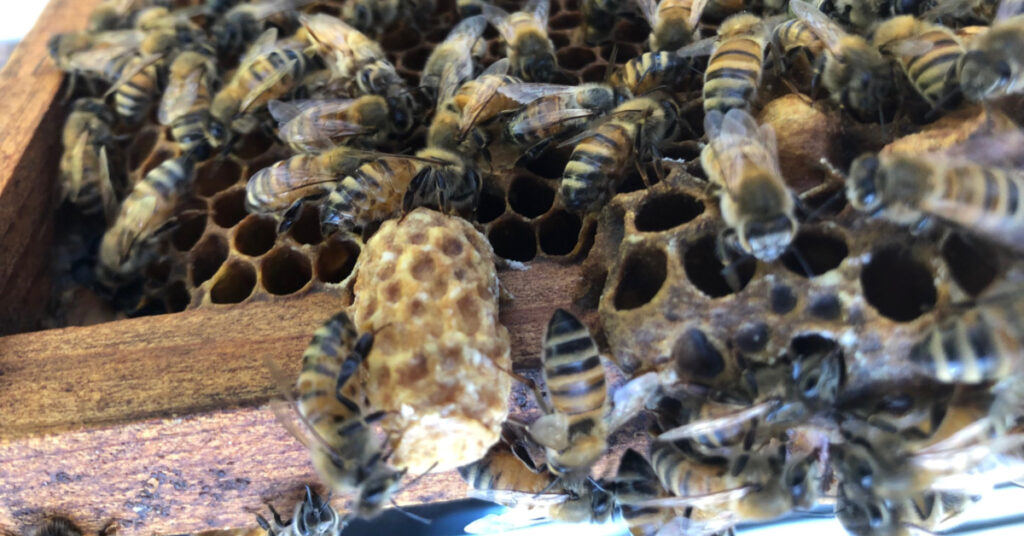
I don’t like swarms, even though swarming is a natural part of hive reproduction. (See this post for a more detailed explanation of what a swarm is and why it occurs.) When one of my hives swarms, I consider it a failure on my part. In this case, I failed to realize how fast the nuc grew. Sure, I can blame the weather, but that’s an excuse. If I am being honest with myself, the nuc got to that stage because of a lack of attention on my part.
Preventing a Swarm
What did I do to prevent a swarm? I split the hive. I move the queen and two frames of brood, a frame of food, a frame of empty comb, and a frame of foundation to a nuc box. Why a nuc box and not a full size hive? Because I have no more bottom boards and lids for full size hives. (I’ll be making more equipment later this week.) So much for my plan to get ahead equipment-wise. I just didn’t expect to have seven hives this early in the year.
I also took a frame with two swarm cells and added it to the earlier split that had lost its queen on the mating flight. In a few days, the queens will hatch. The first to hatch will kill the other queen before she hatches. If they hatch at the same time, they will fight it out and the strongest will survive. (The same thing will happen with the cells I left in the main hive.) With any luck and better weather, the queen will then survive her mating flight and return to build a new hive.
Too Many Hives
You may recall that my wife and I discussed stopping at six hives this year. With my latest split, I now have seven. (Oops.)
I’ve already found a place to put more hives, and she has approved it. It’s on the other end of our property where the bees won’t bother her while she gardens. I’ll need to clear some brush, build some more hive stands, and get another electric fence charger and a few poles. Sounds like an excellent summer project.
Where We Stand
I made it through the winter with two of my three hives alive. Thanks to acquiring two nucs and splitting three hives, I now have seven beehives. Here’s how things look now:
- I have two strong hives that should produce honey for harvesting in both the spring and summer honey flows.
- I also have a growing hive which may make some spring honey and should make honey in the summer.
- One hive has a new queen and should produce honey this the summer.
- There are three small hives that are recent splits with queen cells inthem. Time will if the queens survive and the hives grow. There’s plenty of time to still have them ready for the summer honey flow. I just need to monitor them, make sure they are queenright, and take steps to prevent development of swarm cells. Of course, this is what a good beekeeper should do for all their hives.
I won’t predict how big my honey harvest will be, but I bought enough jars to hold 84 pounds of honey.
